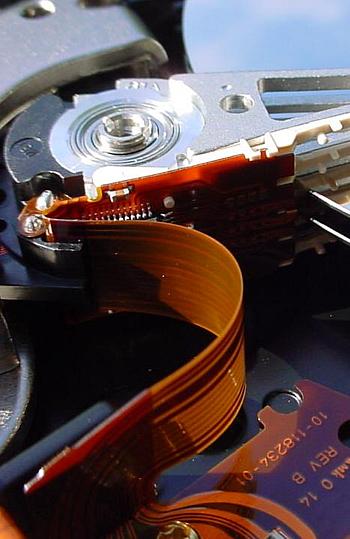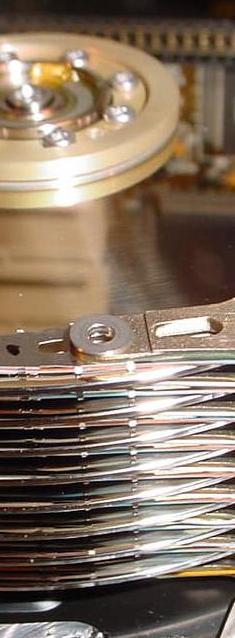The five majors
1:MAXTOR is one of the grand old names in the storage industry and has made some great drives. In the eighties Maxtor was a powerhouse. The excellent 212MB 7213 was our mainstay for years, and the subsequent on 245MB and 345MB drives were very popular too. But Maxtor's follow-on products were ordinary: they looked cheap and were not as reliable as the Maxtor drives of old. Maxtor struggled to stay solvent in the mid-Nineties and its R and D budget suffered.
Korean giant Hyundai bought the company out in 1996 and gave Maxtor the financial stability it needed to get back to developing quality drives. Maxtor's once-huge market share had dropped to a mere five percent, but it was were holding the line and making money. Maxtor still had significant design skills, and its latest desktop drives were suddenly full of high-tech features like MR heads, 5400 RPM spin rates, and PRML read channels. Maxtor was back!

In 2001 Maxtor, at that time the number four player, merged with Quantum, the world number two, to create a giant even bigger than Seagate. Mergers are rarely successful and normally lead to reduced overall market share — as Seagate found when it bought out Conner — but Maxtor have an excellent product range right now and have often showed the ability to surprise us in the past. Watch this space!
2:SEAGATE is the traditional world number one in hard drives, now the second biggest since the Quantum-Maxtor merger, is one of the longest established manufacturers, and makes an incredible range of drives from inexpensive and reliable mass-market IDE drives to state of the art ultra high performance SCSI systems.
Seagate is particularly strong at the high end of the market, and has a long list of world-leadership products in its history.Seagate was the first drive manufacturer to release higher speed 5400, 7200, 10,000, and 15,000 RPM drives, and consistently produces more very fast enterprise class SCSI drives than any other manufacturer.
Seagate are also strong in the desktop market, generally focussing on low-cost, high-volume drives of modest performance, but breaking the shackles every now and then to make an out-and-out performer. Seagate also manufactures a lot of components for other drive makers, particularly read-write heads.
Seagate merged with Conner late in 1995 and experienced a slump in the couple of years following. It misread the market and was slow to make the transition to MR heads and PRML read channels, which gave other makers (notably Quantum) the opportunity to take over leadership in the high-performance IDE market. 1998 was a much better year: Seagate introduced several excellent new products, including the world's first 7200 RPM IDE drive, and a still-faster version of the incredible 10,000 RPM Cheetah.
In recent years, Seagate desktop drives have been generally unimpressive — some of the thankfully discontinued U Series drives were very poor efforts — and the company lost a a lot of goodwill when it slashed its warranty cover in 2002. Here at Red Hill, we used more Seagate drives than any other make for eight years running, and while we are mostly selling Samsung drives at present, no doubt we will return to the fold sooner or later.
3:HITACHI now owns and manages the former IBM Storage Division. In Japan, Hitachi is a huge concern, and Hitachi drives have always been quite high-tech. Never really a major player on the desktop market, Hitachi produced a range of well-regarded SCSI drives and (more frequently seen here Australia) fast, reliable little notebook drives.
The organisation that is now Hitachi's storage division was for many years part of IBM. While Seagate can justly claim to have developed the world's first PC hard drive, it was IBM that originally invented the hard disk drive 40 years ago, and IBM that has invented most of the major improvements to it since that time. (In 1996, for example, IBM were responsible for 296 patented storage inventions. Seagate had 92, Quantum 49, Maxtor 17, Iomega 11, Read-Rite 9, and Western Digital 4 — though this is to overstate Iomega's role: that company is more famous for patenting things and going to court about it than it is for actually inventing them.)
IBM invented PRML read channels and magneto-resistive head technology, and all IBM drives used MR heads long before they became common in other makers' products. IBM notebook drives in particular have long been a technological tour-de-force. IBM Storage was also a major supplier of disc drive components to smaller manufacturers. Here at Red Hill we used to carry more IBM drives than any other brand except Seagate, right up until just before the sudden fall from grace at the end of the century.
No-one seems to know just what went wrong at IBM Storage: up until the 75GXP IBM had been not just performance and technology leaders but a byword for reliability as well. But in the wake of major public concerns about the 75GXP fiasco and the way it was handled, and in the face of plummeting market share and mounting losses, IBM sold off the desktop and notebook drive divisions to Hitachi. Hitachi seems to be slowly but surely succeeding in the task of restoring public confidence in this once all but untouchable line of drives.
4:SAMSUNG is justly famous for monitors and RAM production. In the old days when 250MB was a big drive, Samsung hard drives were very cheap, surprisingly fast, and notoriously unreliable. Modern Samsung drives are reasonably priced, perform well, and have earned an outstanding reputation for bulletproof reliability. In recent years, Samsung has been the only hard drive maker with sufficient confidence in its products to offer an across the board three year warranty on all products.
Samsung does not make the exotic, low-volume drives that often gather headlines but are rarely seen in systems. Instead, Samsung specialises in general-purpose mid-size mainstream drives, and in recent years has done this better than any other firm in the industry. Samsung drives are generally regarded as the most reliable hard drives on the market today. Samsung's market share is steadily expanding, the parent company is both large and financially sound, and our guess is that Samsung will continue to prosper.
5:WESTERN DIGITAL has always been a very well-known name here in Australia. Besides hard drives, WD used to make a wide range of other electronic components; it started as a controller card manufacturer, and later produced a range of superb 32-bit Paradise video cards — though it sold this division to Phillips some years ago.
Through the mid-Nineties WD hard drives consistently had the lowest access times of any on the mass-market, though their data transfer rates were usually less outstanding. WD were the last major maker to embrace MR head technology, largely because of component supply issues. WD thin-film drives continued to perform well just the same, and the eventual switch to more modern technology produced some excellent drives.
Like Quantum, Western Digital was very strong on the desktop but never dominated the high-end market the way Seagate and IBM did. Again like Quantum, WD pushed hard to break into the lucrative SCSI arena, and had an active R and D department. Unfortunately, the most visible WD initiatives in the closing years of the century, SDX and 3.0 inch notebook drives, came to nothing and in the face of massive losses WD was forced to refocus on its heartland: fast 3.5 inch drives for desktop PCs.
In 1999 Western Digital suddenly dropped its longstanding in-house design policy and began making IBM-designed drives with IBM-manufactured parts and Western Digital badges, including the superb '99 Drive of the Year winner, the Expert. Most observers thought that WD would soon be just another name for IBM Storage, but no sooner had the world got used to this new-look Western Digital than the company switched back again! WD drives are once more WD designs with parts sourced from independent suppliers.
Western Digital is the smallest and most vulnerable major, and the most prone to sudden swings in product speed and quality. In a good year, WD drives are faster than most and as reliable as any. Although small, Western Digital has survived its hardest times already, often has great products, and looks set to remain successful.
